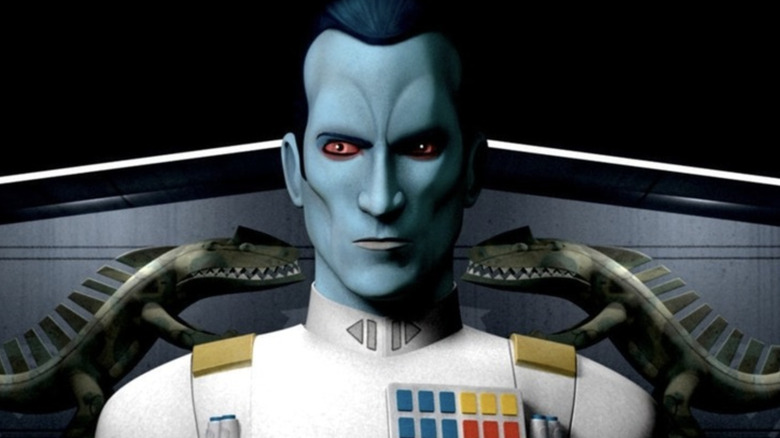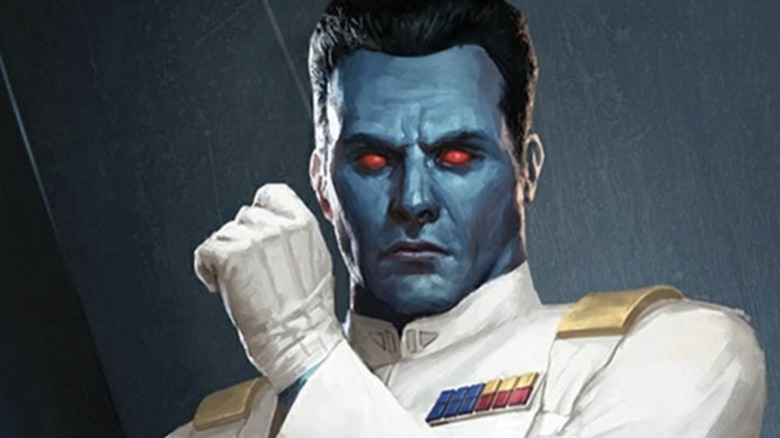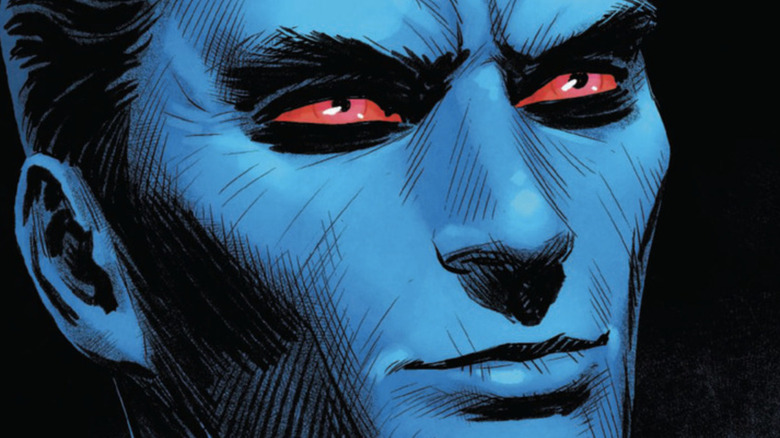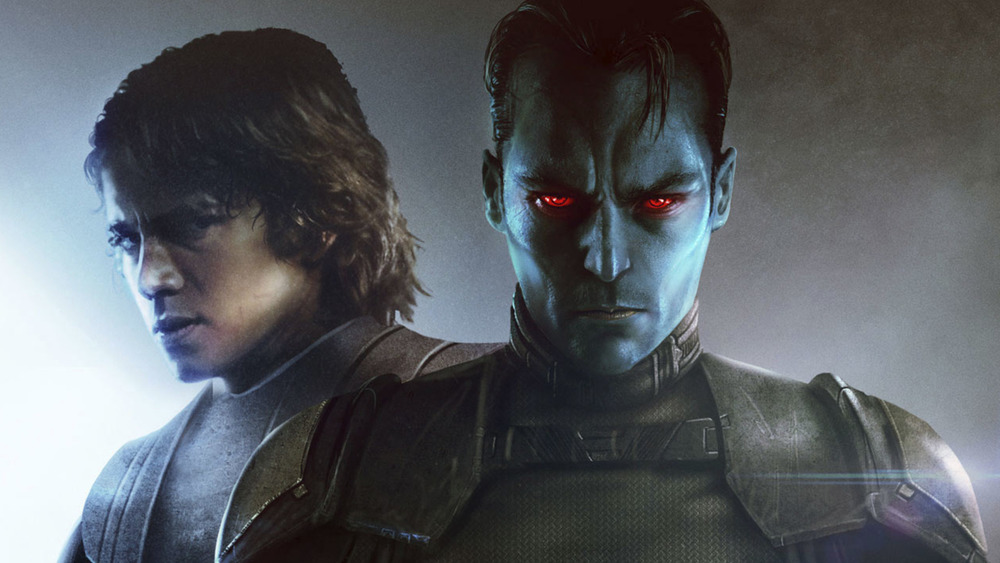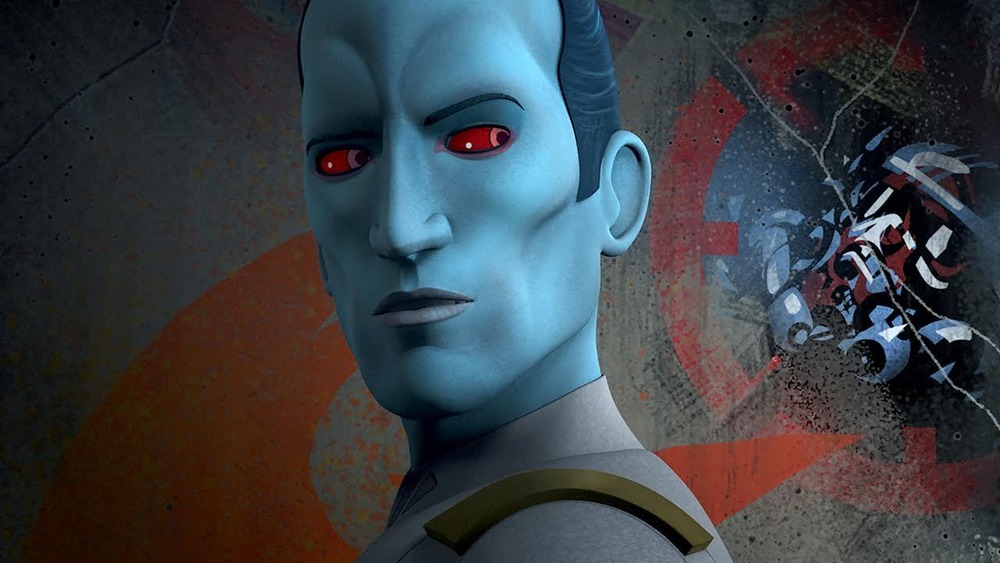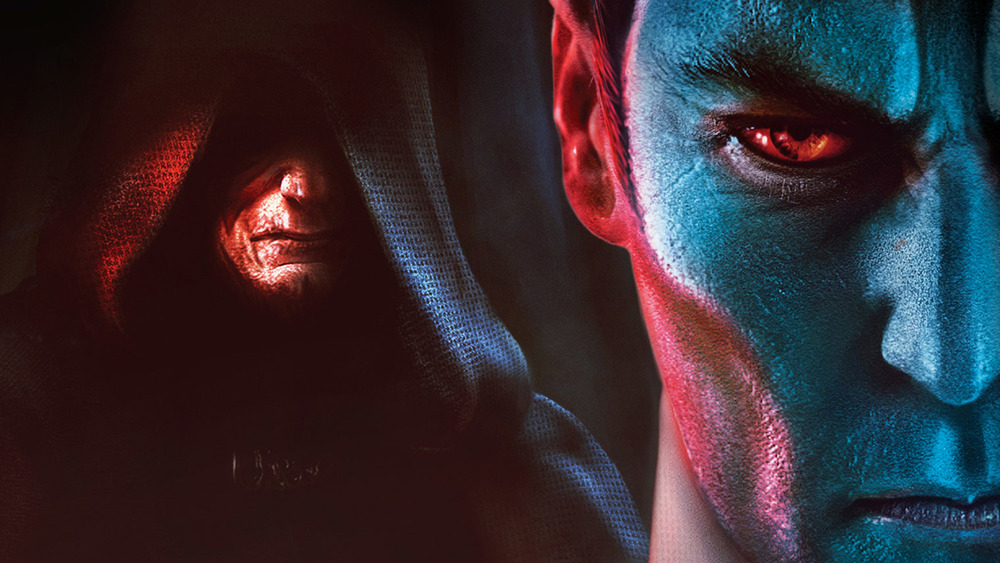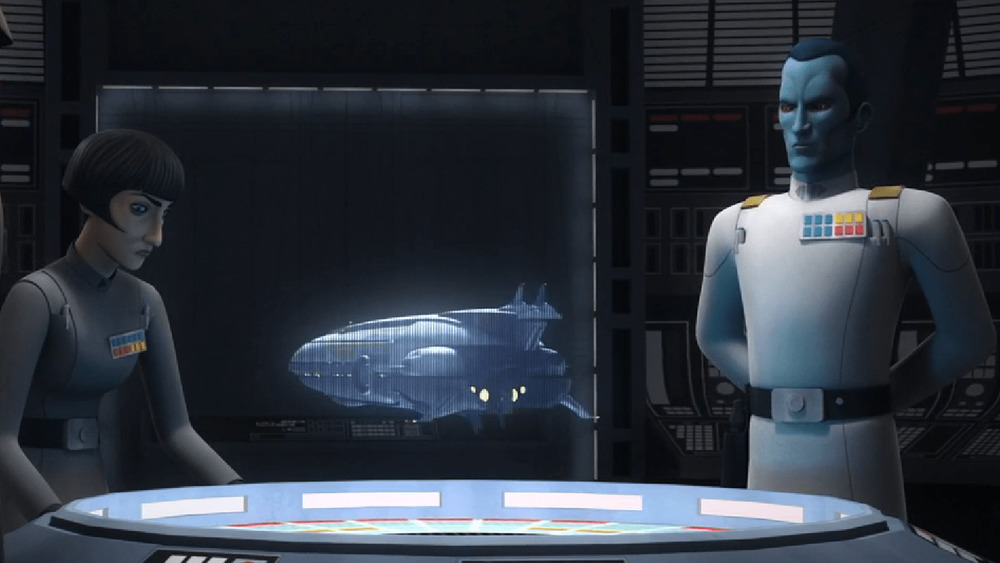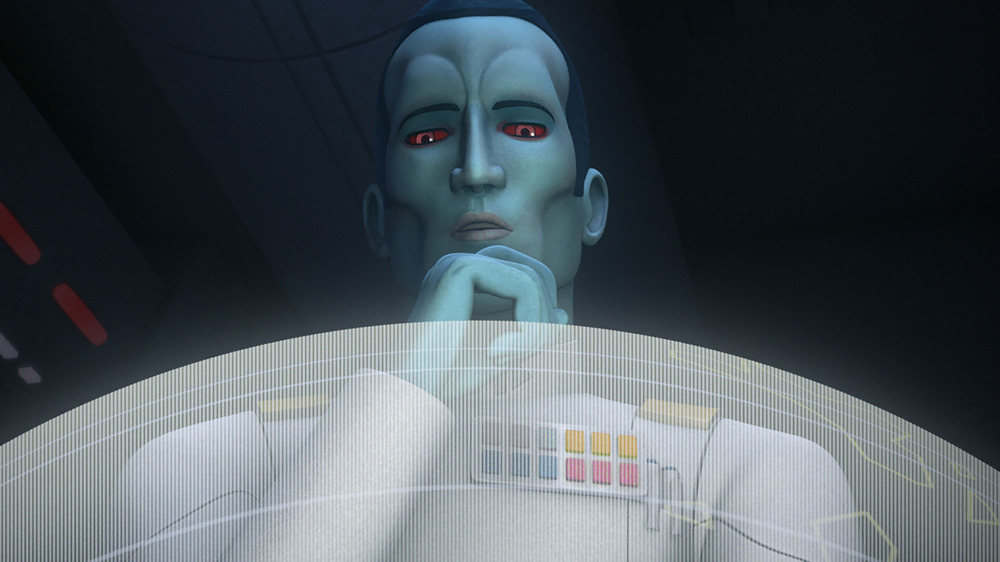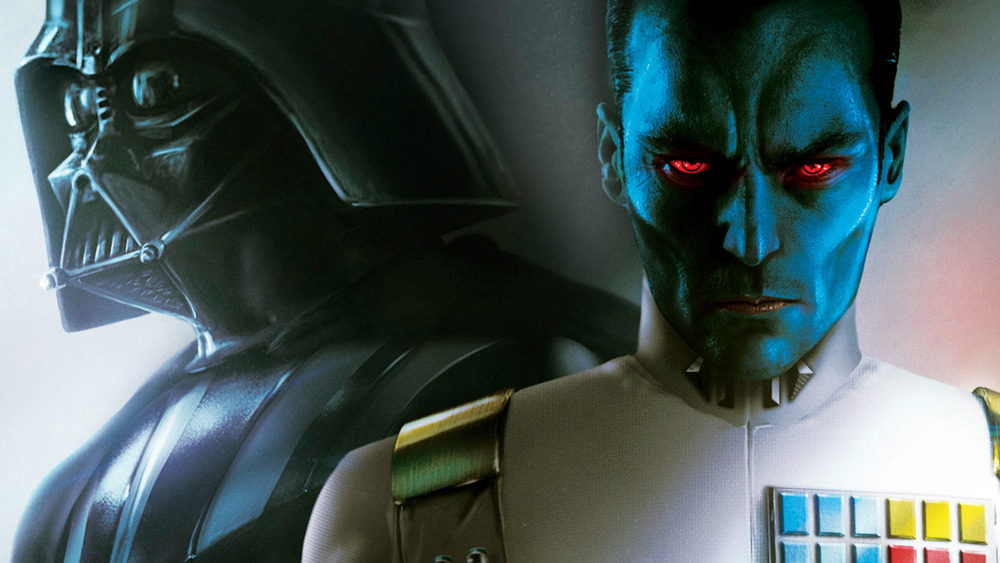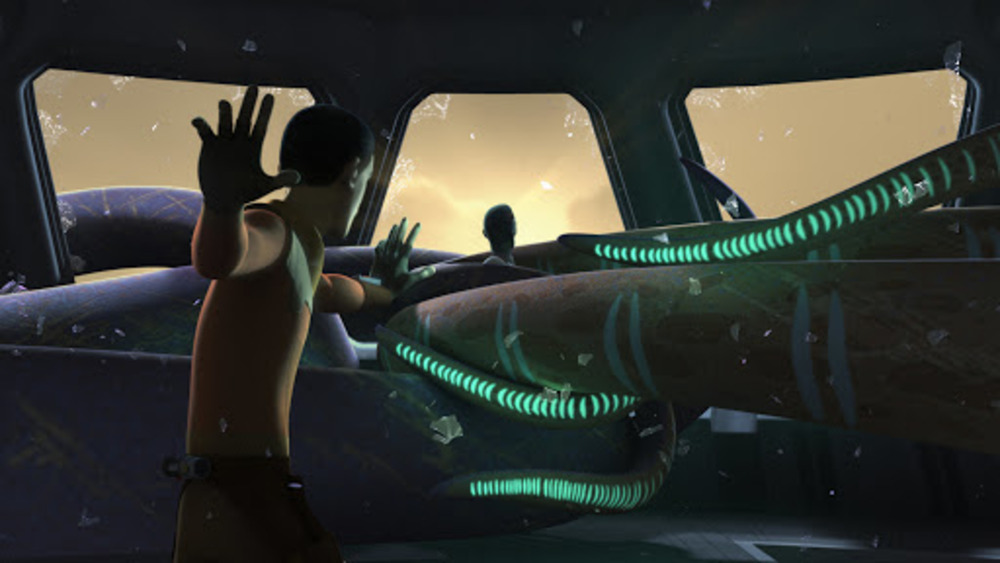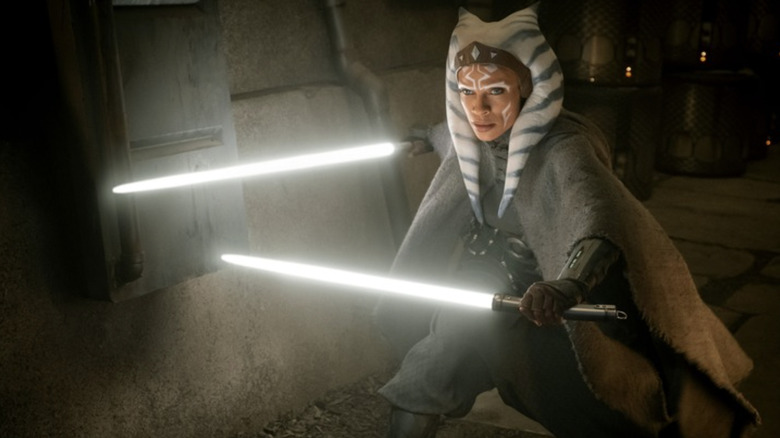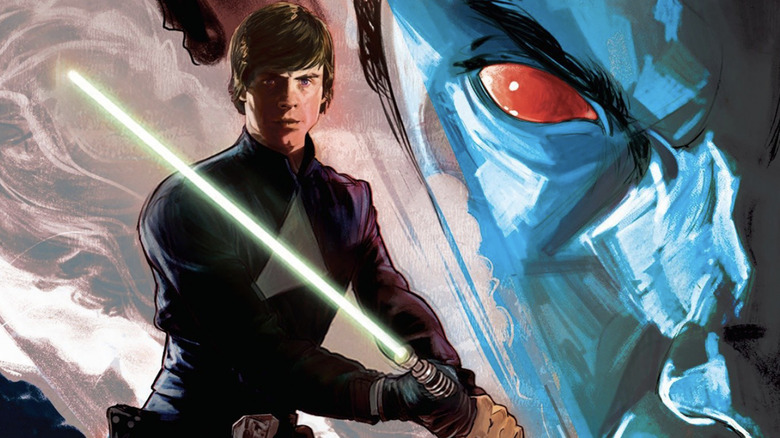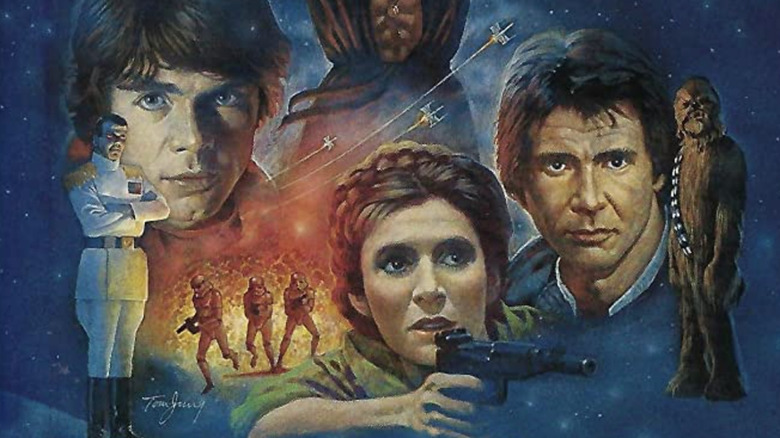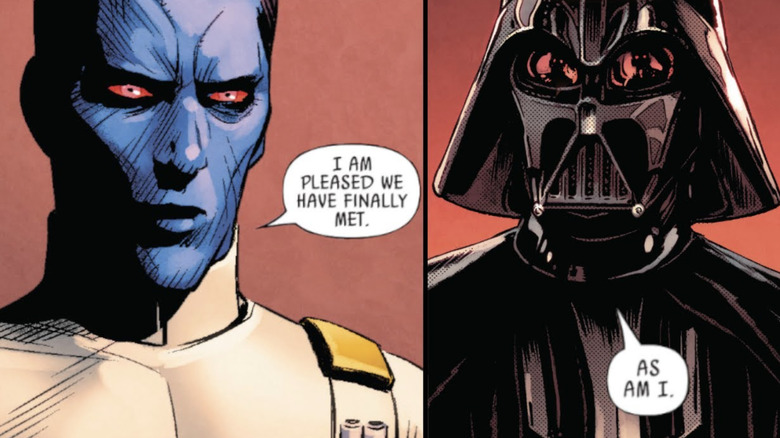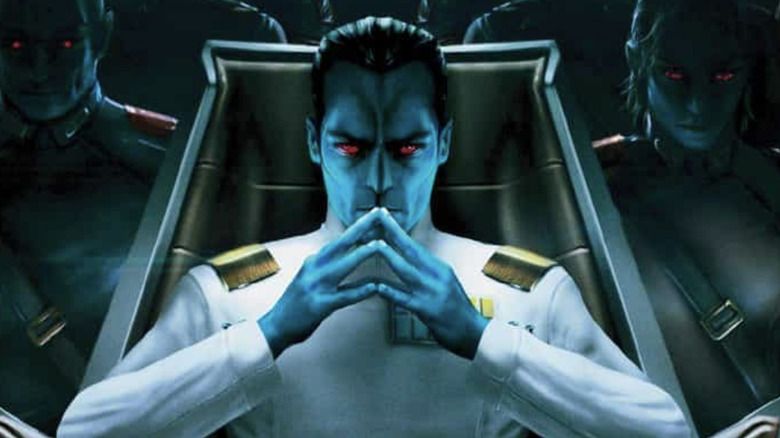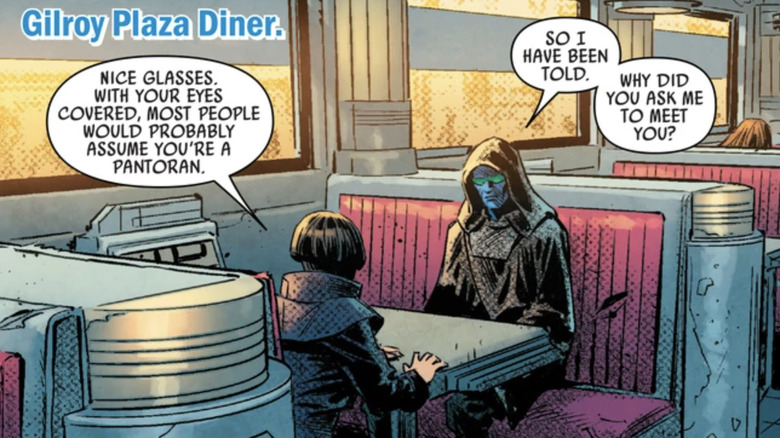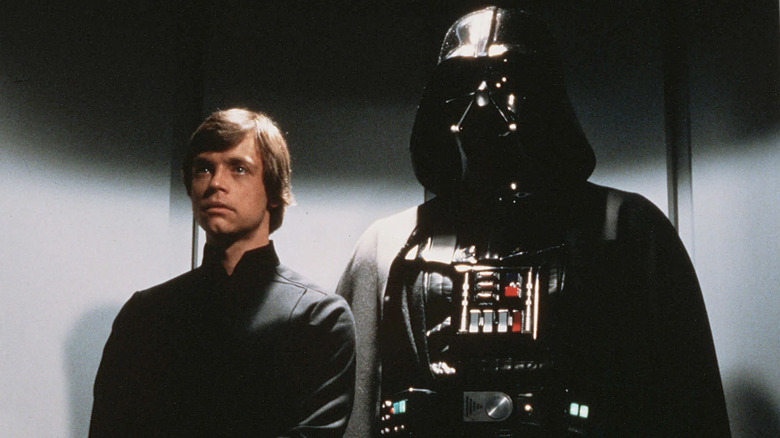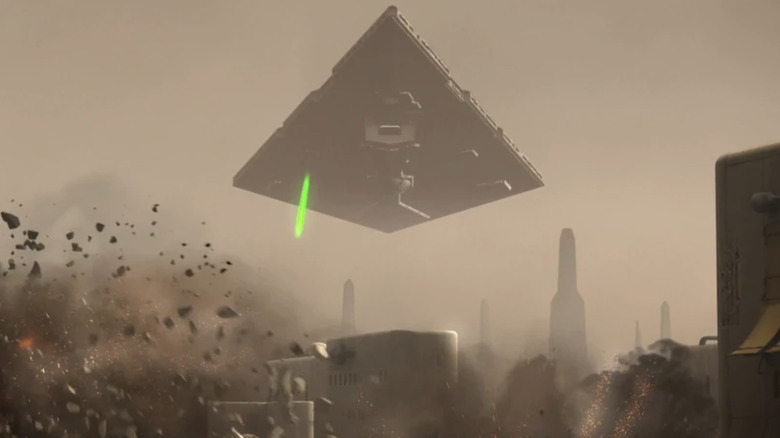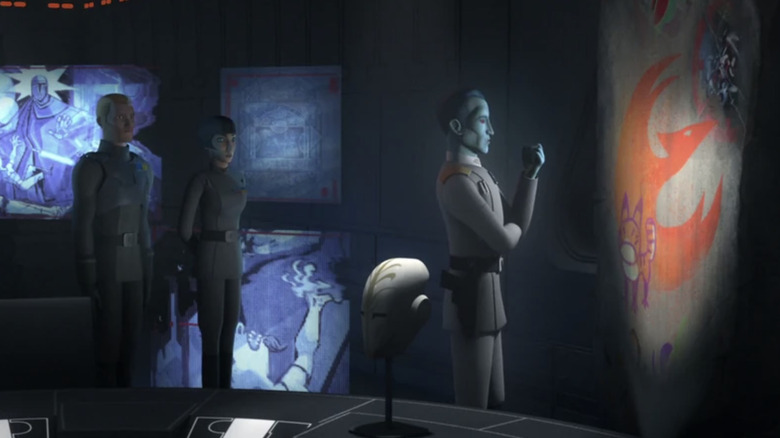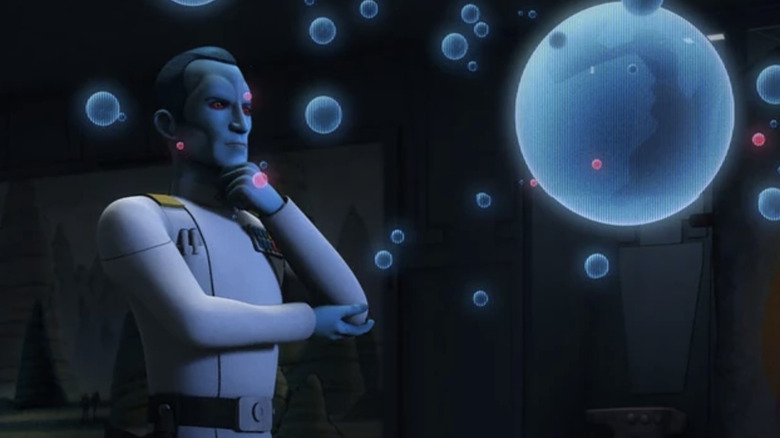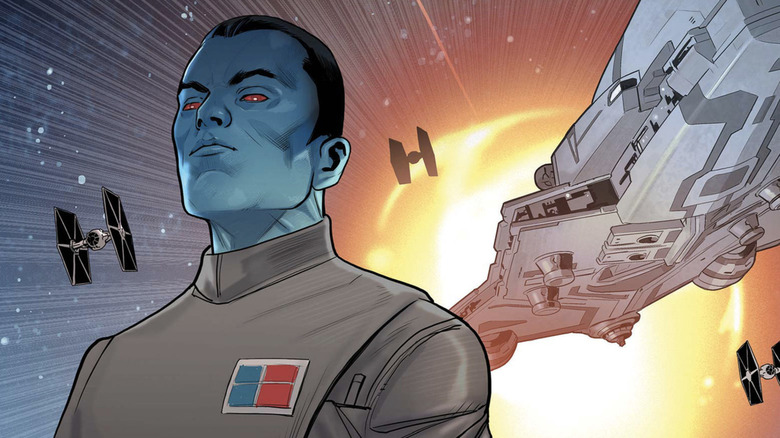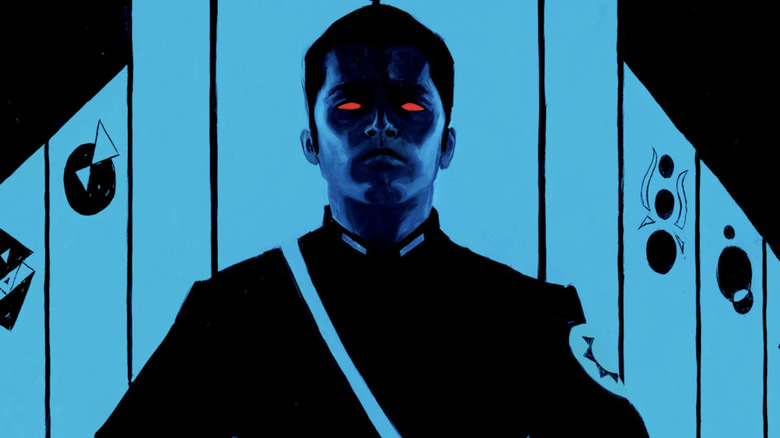The Untold Truth Of Grand Admiral Thrawn
Among die-hard "Star Wars" fans, Grand Admiral Thrawn is one of the more recognizable villains. With red eyes against blue skin and analytical skills setting him apart from your typical baddie, he's a force to be reckoned with.
Thrawn originally started off as the main baddie in author Timothy Zahn's "Thrawn" Trilogy of novels in the '90s, squaring off against the likes of Luke, Leia, and Han in the aftermath of Emperor Palpatine's death. While the trilogy was ultimately deemed non-canon in the wake of Disney's purchase of Lucasfilm, Thrawn clawed his way back from oblivion, making his first onscreen appearance in "Star Wars Rebels" and returning to the official franchise canvas once again.
Although "Rebels" details Thrawn's exploits against the early rebellion, it covers little else. But new novels and comics have been constructed to give fans a better understanding of how he came to serve the Empire, where he's from, and what his ultimate goals were. Though the original pre-Disney continuity only included Thrawn in a post-"Return of the Jedi" world, his reintroduction has expanded this history to the original trilogy, and even further back to the infamous Clone Wars. Such details could shed some light on what Thrawn was up to after "Rebels" — and why Ahsoka Tano is hunting him in "The Mandalorian" and into her own upcoming Disney+ solo series. With all that in mind, here's a look at the untold truth of Grand Admiral Thrawn.
The Chiss
Although Thrawn was the main antagonist of "Star Wars Rebels" for two of its four seasons, precious little was revealed in the show about his origins. However, the "Star Wars: Thrawn" novels plug the gap nicely, revealing much about Thrawn's people, the Chiss.
The Chiss are a race living in the Unknown Regions, an area made remote by such space obstacles such as black holes, keeping them largely hidden from outsiders. However, this isolation was a double-edged sword, as they lacked access to technologies such as navigation computers to traverse the dangers of the area in which they lived. Fortunately for the Chiss, some of their young can be gifted with a strong connection to the Force, giving them the ability to chart safe courses through the Unknown Regions. However, the Chiss rarely if ever venture out of their home area, because they are governed by the ruling body known as the Chiss Ascendancy, further isolating them from the rest of the galaxy by enacting policies to prevent their discovery.
Though Thrawn's birth name was Kivu'raw'nuru, because of his distinguished service in the Chiss military, his name was changed to "Mitth'raw'nuru" as a sign of respect. This is how he ended up with the shortened name Thrawn. Thrawn earning a new name from the Chiss military shows that, above all else, he is loyal to the Chiss Ascendancy and his people — a loyalty that would be tested in future battles.
The Grysk Hegemony
While the Chiss were one of the species living in the Unknown Regions, they were far from the only ones. In fact, their biggest threat was an alien race called the Grysk.
Known for their warlike nature, the Grysk have the ability to employ a form of mind control against their enemies, compelling them to do their bidding. The Grysk are ruled by a Hegemony very similar to the Galactic Empire in make up, with the biggest similarity between the two governments being a desire to expand their influence. In studying the Grysk and their tactics, Thrawn inadvertently made himself an invaluable asset for Palpatine's Empire. But the battle against the Grysk wasn't without its own complications.
Where the Empire (as seen in the "Star Wars" saga) is in power for a relatively brief period of time, and had to deal with the end and beginning of two Galactic Civil Wars, the Grysk were established early enough that they were able to monitor the Clone Wars, indicating their ambitions were planned out for some time. While the Grysk had plans for aggressive expansion, they had to go through their sworn enemies — the Chiss — to realize their goals.
The Chiss Ascendancy realized this and sought allies in order to fight the Grysk — a task eventually given to Captain Thrawn. He had his work cut out for him: With their mind control abilities and plans to eliminate the Chiss, the Grysk were clearly a force with which to be reckoned.
Working with Anakin Skywalker
Eventually, Thrawn was sent by the Chiss Ascendancy into the Outer Rim to determine if the Republic could be trusted to eventually fight with the Chiss against the Grysk Hegemony. His travels led him to the planet of Batuu, where he encountered Anakin Skywalker, who was searching for the missing Senator Amidala. Thrawn and Skywalker agreed to help each other, with Thrawn helping Skywalker on his mission and Skywalker informing Thrawn of the finer details of the Republic. While the two failed to locate the missing Senator, they did discover a Separatist factory creating droids with a rare metal known as cortosis. When Skywalker attempted to use his lightsaber to destroy them, it failed to cut through the droids — rather, their cortosis armor blocked his lightsaber, similar to the way the Mandalorian's beskar armor blocked Ahsoka's lightsabers. This surprising setback resulted in Thrawn's and Skywalker's capture.
Thrawn and Skywalker part ways
Luckily for the duo, Senator Amidala was conducting a separate infiltration mission, and managed to free them. Around the same time, Chiss reinforcements were sent to Batuu, along with orders for Thrawn to help them capture a shield generator. Thrawn, with his loyalty to the Chiss coming above all else, complied with the order, but sent his troops to help Skywalker destroy the droid factory after they captured the generator.
With both their missions successful, Skywalker taught Thrawn more about how the Republic worked, fulfilling his end of their bargain. Although Thrawn had come to respect Skywalker, he deduced from what he learned that the Republic could not be trusted to fight the Grysk, and Skywalker and Thrawn both departed Batuu. This was the only time the two would meet prior to the rise of the Empire: when they next encountered each other, Thrawn was working for the Empire, and Skywalker had completed his fall to the dark side of the Force and become Darth Vader.
Working for the Empire
Thrawn's loyalty to the Chiss was above all else. So how and why did he come to serve the Empire? The why is surprisingly simple: the Chiss Ascendancy needed to determine whether the Empire could help them defeat the Grysk Hegemony, so they ordered Thrawn to join the Imperial military. Their plan was that he would either convince the Empire to stand with the Chiss against the Grysk, or manipulate events such that the Grysk would attack the Empire first, giving the Chiss more time to prepare.
The how is a bit more complicated. To help convince the Empire he had nowhere else to go, Thrawn faked his exile. Then he chose a world he knew the Empire would eventually explore and he waited. Once the Empire came to the planet, he slowly and methodically picked off their scouting party, eventually forcing their retreat. Thrawn took this opportunity to sneak aboard an Imperial ship and allowed himself to be captured. Once on board, he told his "story" to the ranking officers. Impressed with his tactical skills, they brought him before Emperor Palpatine.
Thrawn was able to use his past experience with Skywalker to gain the Emperor's favor. Although Thrawn didn't receive any guarantees, Palpatine did agree to consider helping the Chiss if Thrawn served the Empire faithfully. Although Thrawn did ultimately swear allegiance to the Empire and Palpatine, every action he took to get to the Emperor proved that his loyalty to the Chiss remained undimmed.
Alliance with Arihnda Pryce
While Thrawn held up his end of the deal to serve the Empire faithfully, his methods put him at odds with some high-ranking Imperial officials. In order to protect himself from the threat of a court-martial, he attended several parties held by powerful members of the Empire. At one such party, Thrawn came into contact with Arihnda Pryce, an ambitious government employee. Although nothing significant occurred in their first meeting, their connection would prove to be mutually beneficial. When Pryce was blackmailed by a rival, Thrawn gave her valuable advice to turn the tables. This advice allowed her to thwart her blackmailer and become governor of the Lothal Sector.
Some time later, Pryce and Thrawn worked together on a military campaign to crush a small group of rebels on the planet Batonn. Pryce was responsible for a large amount of civilian casualties, which outraged Thrawn. He initially planned on reporting Pryce's misdeeds to the Imperial Security Bureau, but was convinced otherwise when Pryce offered to get Thrawn promoted to Grand Admiral — a ranking Thrawn understandably coveted, as it would allow him to better proceed with his primary mission for the Chiss. Pryce's offer was conditional upon Thrawn bringing his fleet to the Lothal system to deal with the rebel cell known as Phoenix Squadron, which Thrawn agreed to do. Although Thrawn allowed Pryce to walk free, he was able to continue his primary mission: convince the Empire to fight with the Chiss against the Grysk.
Hunting down Phoenix Squadron
Thrawn started his war against Phoenix Squadron almost immediately after receiving his promotion to Grand Admiral. Although he had an opportunity to destroy the rebel ship Ghost, along with the Jedi Ezra Bridger and Kanan Jarrus, during a raid at Recklam station, Thrawn let them go in order to reel in a much larger prize: the location of Phoenix Squadron's hidden base.
In order to better understand how the rebels operated, Thrawn spent much of his time analyzing their past and their strategies. Thrawn's almost religious study of all things Phoenix Squadron paid big dividends when he recognized some distinctive artwork on the helmet of a supposed "bounty hunter" Imperial Agent Kallus captured. After deducing the bounty hunter was in fact Ezra Bridger, Thrawn realized Kallus was a double agent. He allowed him to continue operating as one until he made his next transmission to the rebel base. Thrawn then tracked the transmission to the planet of Atollon and launched an all-out assault, defeating and scattering the rebels. His efforts to capture them, however, were thwarted by a creature known as the Bendu. After being shot down, the Bendu foretold Thrawn's ultimate defeat would be "like many arms, surrounding him in a cold embrace." Although Thrawn was victorious over Phoenix Squadron in the short term, the Bendu's words would come back to haunt him.
Grysk encounters
Shortly after defeating the rebels on Atollon, Thrawn was ordered by Palpatine to accompany Darth Vader to investigate a disturbance in the force on Batuu — the same planet on which Thrawn and Skywalker first met. The two located and captured a band of mysterious aliens, who turned out to be the mortal enemies of the Chiss — the Grysk.
After ascertaining the location of their base, Thrawn and Vader led an assault and, after defeating the Grysk, located the source of the disturbance Palpatine felt: Force-sensitive Chiss children, whom the Grysk had captured in order to make them serve as navigators. Although Vader wanted the children eliminated, Thrawn assured Vader the Force-sensitive Chiss would pose no threat to him, since their connection to the Force grew weaker when they reached adulthood. After rooting out the remaining Grysk forces and rescuing more Chiss children, Thrawn was able to return them to the Chiss Ascendancy; however, he learned the Chiss were heading toward a civil war, with the Grysk backing one of the Chiss factions. Thrawn then reasoned that, since the Grysk were attempting to capture navigators, it was likely that they were preparing to eliminate the Chiss so they could expand into the Empire. While Thrawn continued to serve the Empire in the aftermath of the incident, the actions he took to rescue his people and eliminate the Grysk made it crystal clear where his true loyalties still were.
The TIE-Defender
In order to curry favor with Palpatine and convince him to help the Chiss against the Grysk, Thrawn decided to develop a weapon which could ensure the Empire's stability for years to come. He chose to improve the Imperial ship known as the TIE fighter by giving it more firepower, a hyperdrive, and a shield capable of absorbing regular starfighter projectiles.
The Rebel Alliance viewed this new TIE fighter, dubbed the TIE Defender, as a threat, since none of their X-wing craft had the firepower to deal with its enhanced capabilities. As a result, a raid was authorized on Lothal, where the nuts and bolts of the project were located. The attack was an abject failure, with nearly every rebel pilot killed and their leader, Hera Syndulla, captured. With his factory safe, Thrawn was informed of a new threat to his TIE Defender project: Project Stardust, a.k.a. the Death Star. Although Thrawn's project had the Emperor's support, Stardust was much more expensive, leading Thrawn to meet with Palpatine personally on Coruscant. Unfortunately, Thrawn's journey to meet with Palpatine proved to be the end of his project, as Governor Pryce blew up all of the fuel for the TIE Defenders while killing the Jedi Kanan Jarrus.
The end of the TIE Defender project had major implications, as it caused Palpatine to continue with the Death Star. It was also a massive blow for Thrawn, as his avenue of gaining favor with the Emperor was closed off to him. The loss of the TIE Defender not only affected the course of the Empire, but also Thrawn's goal of saving the Chiss.
Thrawn's defeat
Following the loss of the TIE Defender project, Thrawn was ordered by the Emperor to crush the rebellion on Lothal and capture the young Jedi Ezra Bridger. Thrawn, eager to regain favor with the Emperor to help save his people, brought the might of the Seventh Fleet to bear, threatening to blow up the capital city unless the Jedi surrendered. After ensuring Bridger was in the hands of the Emperor — holographically, at least — Thrawn returned to the bridge of his capital ship, the Chimaera, and ordered the fleet to bombard the planet. The shelling of the capital did nothing, however, as the rebels on the ground managed to raise a planetary shield.
Although Thrawn had sent his bodyguard, Rukh, to keep the shield offline, the rebels managed to fight off the Imperial forces and ensure the planetary shield's functionality. Upon hearing of the death of Rukh, Bridger entered the bridge and demanded Thrawn's surrender. Although Thrawn was still planning on continuing the fight, he was forestalled by the arrival of Purgil — large space dolphins capable of lightspeed. The Purgil completely decimated the entirety of his fleet, with one Purgil smashing into the bridge of the Chimaera and wrapping its tendrils around Thrawn, fulfilling the Bendu's vision of Thrawn's defeat. The Purgil then jumped to lightspeed, flinging both Bridger and Thrawn to an unknown destination in space, and completely destroying any hope Thrawn had of bringing the Empire to save his people.
Ahsoka and The Mandalorian
Prior to Season 2 of "The Mandalorian" — which takes place about five years after "Return of the Jedi" and nearly a decade after "Star Wars Rebels" — it was presumed that both Thrawn and Bridger had perished when the Purgil jumped to lightspeed, as the windows of the ship's bridge were smashed in, exposing everyone on board to the typically fatal effects of open space. However, Thrawn evidently managed to survive his encounter with the Purgil.
In "The Mandalorian" episode titled "The Jedi," Ahsoka Tano hunts the Grand Admiral while allying herself with the titular Mandalorian Din Djarin, waging war against a cruel authoritarian figure known as the Magistrate in an effort to obtain information as to his whereabouts.
Although the episode doesn't reveal Ahsoka's reasons for hunting Thrawn, it's at least possible that she's doing so in an effort to find Ezra Bridger. Bridger was last seen with Thrawn, after all, and the closing shot of "Rebels" shows the young Mandalorian Sabine Wren leaving with Ahsoka on a quest to find Ezra, who they believe is still alive. When you consider that "Star Wars Rebels" co-creator Dave Filoni is an executive producer on "The Mandalorian" — and also directed "The Jedi" — a connection between the two stories seems all the more likely. In fact, Filoni's next series, Disney+'s upcoming "Ahsoka," will continue the former Jedi's quest. It's clear that fans haven't seen the last of Ahsoka or Thrawn just yet.
The original Heir to the Empire
In 1991, a novel by author Timothy Zahn was released entitled "Heir to the Empire"; it chronicled the adventures of Luke Skywalker, Leia Organa, Han Solo, and their merry band of Rebels following the events of "Return of the Jedi." Set approximately five years later, Grand Admiral Thrawn is introduced as the next in line to restart the Galactic Empire and crush the New Republic. The story continues with the novels "Dark Force Rising" and "The Last Command," where Thrawn's plans are thwarted by Luke and his allies.
A few years later, the author wrote two more novels, serving as a sequel to the trilogy known as the "Hand of Thrawn" duology, and that was only the beginning. The Grand Admiral would be a recurring antagonist throughout the Extended Universe. For decades, the original "Thrawn" trilogy served as the launching point for the greater "Star Wars" Expanded Universe, but when Disney purchased Lucasfilm in 2012, everything changed. Thrawn, like many other characters and stories, was written out of continuity by the House of Mouse, with Zahn's acclaimed trilogy being rebranded under the "Star Wars Legends" banner.
When Thrawn was eventually re-introduced into the Disney continuity, there were significant changes. For starters, unlike in the "Heir to the Empire" story, the Disney versions of Thrawn and Luke never encounter one another. Instead, Ahsoka Tano and Ezra Bridger serve as Thrawn's main adversaries, with Luke off elsewhere re-establishing the fallen Jedi Order.
He might have saved Star Wars
Zahn's trilogy was so successful — selling over 15 million copies — that his work on "Heir to the Empire" is credited by some with saving the "Star Wars" franchise at a time when new adventures were scarce. Following the original theatrical release of "Return of the Jedi" and a few other projects throughout the 1980s, "Star Wars" content had stalled by the early '90s. George Lucas had yet to develop the "Star Wars" prequel trilogy, so Zahn's work singlehandedly carried the franchise, opening the door for more Expanded Universe stories.
Though Lucas didn't consider them canon, he nevertheless took elements, characters, and planetary systems (including the city-planet Coruscant) from the EU and added them to his new films. No doubt, Thrawn's popularity among "Star Wars" fans was a reason why Zahn's trilogy was so successful. For many years, the "Heir to the Empire" trilogy was the closest thing to a direct "Star Wars" sequel trilogy that fans seemed likely to receive, as Lucas largely moved on from the franchise from the mid-'80s to the turn of the century.
Thrawn's reappearances in various novels, games, and comics were quite welcome before Disney swooped in and took over. It also explains why the character survived the House of Mouse's purge of the greater Extended Universe; he was too important to fans to be erased entirely. Some fans still hold out hope that other characters from this era (like Luke Skywalker's wife and former Emperor's Hand Mara Jade Skywalker) could return as well.
Thrawn almost mistook Anakin Skywalker for a Sith
As mentioned earlier, Thrawn had the pleasure of meeting both Anakin Skywalker and Darth Vader during very different phases of the former Jedi's life. The 2018 novel "Thrawn: Alliances" chronicled a partnership between the Sith Lord and the Imperial warlord as they work together to investigate a disturbance in the Force on Batuu. But, "Alliances" doesn't just cover this partnership between Thrawn and Vader, it also flashes back to the Clone Wars, when Thrawn and the young Skywalker worked together to survive and save Senator Padmé Amidala.
It is during this time that Thrawn deduces that Anakin is a Jedi, but only before first internally questioning if he were actually a Sith. Though Anakin thought his role as a Jedi was obvious — given the color of his lightsaber and all — Thrawn explained his hesitation. "Our myths of the Republic speak of two groups of beings with such powers: the Jedi, and the Sith," he says. "But the Sith are reputed to be clever and capable warriors." As it turns out, Anakin's mistakes in combat allowed Thrawn to correctly identify him as a Jedi.
Years later, Emperor Palpatine told Thrawn of Skywalker's death following the Clone Wars. Despite this lie, the Chiss double agent quickly deduced that Lord Vader and the former General Skywalker were one and the same. As one of the only people in the galaxy to uncover this safeguarded information, Thrawn wisely kept it to himself. Smart move, Thrawn.
His sister had Third Sight
Since the Chiss were so far removed from the Republic, they had little to no knowledge of how their society worked. The Chiss were an isolationist people, and though Thrawn often saw the benefits of the Empire's reach, he was ultimately loyal to the Ascendancy. Nevertheless, the Force still extends into the Unknown Regions, even if the people who reside there don't actually know what the Force is. For the Chiss people, Force-sensitive children may not have the same giftings as other races do, but they still retain a premonition ability which they call "Third Sight."
Because of their ability to peer into the future, children with "Third Sight" are conscribed to become sky-walker navigators (no relation to the Skywalker family) since the Chiss don't use traditional technological navigation. Thrawn's older sister Kivu'rik'ardok, known as Vurika, was one of these Force-sensitive children, and was taken when he was just a boy. As an adult, like many Chiss children with Third Sight, Vurika lost her precognitive abilities and instead worked as an instructor for future sky-walkers.
Despite being siblings, when confronted with the chance to finally meet her long-lost brother, Vurika — now known as Cohbo'rik'ardok aka Borika — cried, believing that there was no point since her memories of Thrawn had long faded. Tragically, Thrawn never reunited with his sister, having believed that one day he might use his resources to find her. Eventually, he comes to respect her wishes for anonymity and moves on.
He's sometimes mistaken for a Pantoran
The vast galaxy of "Star Wars" is home to a plethora of different alien races of varying shapes, sizes, colors, and creeds. Wookies aren't too far off from sasquatches, and Ewoks look like oversized teddy bears. Yes, humans somehow exist too, but there are some other races out there that don't look too far off.
This brings us to the Chiss and the Pantoran peoples. Grand Admiral Thrawn's dark blue skin and bright red eyes are a staple for the character, making him unique from the rest of the "Star Wars" cast. But his people aren't the only ones with distinctly blue skin. The Pantorans, who hail from the Galactic Republic moon of Pantora, are similarly colored, but with eyes generally more akin to the human species.
Because the Chiss originate from the Unknown Regions, not many within the Republic or the Empire know much about Thrawn's people. As a result, many have incorrectly assumed that Thrawn is a semi-disfigured Pantoran, whose red eyes are more akin to a curse than an anomaly. In fact, with glasses and a hood, Thrawn can be virtually indistinguishable from your average Pantoran, prompting him to use the disguise as a cover. Though few species in the "Star Wars" universe look alike, the Chiss and the Pantorans could easily be cousins, and though their cultures and loyalties are vastly different, their similar appearance was of note to those who encountered Thrawn during his time with the Empire.
Thrawn's disappearance led to Vader hunting the Rebels
The events of the "Star Wars Rebels" finale, in which Ezra Bridger and Thrawn were thrown into the unknown, are set the same year as "A New Hope," the original Star Wars film.
In that movie, the Empire lost Grand Moff Tarkin and the first Death Star at the hands of Luke Skywalker. After these two enormous defeats, the Emperor tasked Darth Vader with personally overseeing the destruction of the Rebel Alliance. "Thrawn or Tarkin would be perfect for the assignment," Palpatine told his apprentice in "Star Wars" #8, set after Vader's battle with Luke in Cloud City. "But both are gone." Though this might delay the Sith Lord's search for his long-lost son, it was necessary for the health of the Empire.
In Thrawn's absence, Darth Vader continued to hunt down the merry band of Rebels that threatened his master. During the "War of the Bounty Hunters," he was close to capturing Captain Han Solo and a number of his allies but ultimately failed. Had Thrawn still been around, these events might not have gone as well for Luke and his friends as they did, and it's entirely possible that Luke may have been captured prior to his surrender in "Return of the Jedi." Likewise, Vader's position overseeing construction of the second Death Star may have been held by someone else had Thrawn or Tarkin survived, meaning his turn back to the Light Side might've never occurred.
He prefers to avoid civilian casualties
Although Thrawn is often seen as a ruthless leader, willing to do whatever it takes for the sake of his Imperial — or rather, Chiss Ascendancy — goals, this couldn't be further from the truth.
From the time he was a young man, Thrawn saw all lives as holding some sort of value. Though he had no problem killing his enemies, he saw the deaths of innocent civilians as senseless and unnecessary. "All lives are important, and I resist the thought of standing by and watching two hundred possibly needless deaths," Thrawn told his allies in Timothy Zahn's novel "Greater Good." This was especially true of Thrawn when he served in the Chiss military, but it generally carried over to his time with the Empire as well.
Generally speaking, Thrawn showed deep respect for his enemies as well, but this only went so far. In "Star Wars Rebels," Thrawn unleashed his full fury on the Lothal system near the end of his time there. After his increasingly futile attempts to put the insurgency down, he fired on the people of Capital City until Ezra Bridger surrendered himself to the Empire. It's worth noting that these actions were due to intense pressure from Emperor Palpatine, who hoped to turn Ezra to the Dark Side, but Thrawn was certainly still the man in charge. Had Thrawn been given more time, he may have come up with an alternative solution that didn't threaten the lives of those below.
He's an art lover
An interesting shade to the Thrawn character is the Grand Admiral's love, or at least professional appreciation, of both traditional art and music. Believing the arts to be a window into the history and culture of different people groups, Thrawn sees it as a valuable tool to be used to better understand his allies and opponents.
In the Zahn novel "Lesser Evil," a younger Thrawn is depicted analyzing hundreds of thousands of different pieces of artwork that belonged to his adoptive family, many of which were created by countless unnamed artists. Among these pieces, he connects a series of seemingly unrelated works together based solely on style and technique, eventually discovering the artist's identity.
Likewise, in "Star Wars Rebels," Thrawn amassed an impressive collection of artwork that all pointed to the members of the Rebel ship the Ghost, which included Ezra Bridger, Sabine Wren, and Hera Syndulla. In his time studying their work, he came to better understand his enemies and used this knowledge of their goals and ideals to overpower them. Across his various media appearances, this appreciation for the arts has remained a strong, consistent character trait for the Chiss warlord.
Though Thrawn isn't much of an artist himself, his knowledge and understanding of technique and structure have proven invaluable to his military campaign. Propaganda is a powerful tool after all, no matter which side it's on. Perhaps viewers will see more of Thrawn's art expertise in the "Ahsoka" series.
Thrawn was inspired by historical and fictional characters
Though there are any number of military leaders who could've been the basis for Grand Admiral Thrawn, Zahn revealed via letter in 2002 the exact source of his inspiration.
"Thrawn isn't based on any one historical person in particular, but is more of a composite of the best and brightest military geniuses that have ever lived," he stated. On Zahn's list: Hannibal, Alexander the Great, Robert E. Lee, and Erwin Rommel.
Zahn continued to explain Thrawn's characterization by emphasizing that he, unlike many real-life military leaders, genuinely cares about those under his command. The lives of his officers matter to him, and he has no desire to see any of them gunned down. Since Thrawn was meant to be a different sort of villain than Darth Vader, who ruled his underlings by fear, he was made into "a tactical genius who would be so trusted and respected by his men that they would unquestionably follow him anywhere."
But Zahn wasn't just inspired by the historical leaders of old to construct Thrawn; he was also inspired by popular fictional characters who would likely oppose the Grand Admiral's side of the conflict. Sir Arthur Conan Doyle's famous detective Sherlock Holmes was a clear template for Thrawn's ability to piece together a mystery. Though Holmes uses his exceptional mind to help others, Thrawn uses it to advance the goals of the Empire, which is a bit less noble.
Marvel thought no one would care about the character
Despite being the beloved antagonist of the most well-received "Star Wars" novels, the editors at Marvel Comics — who hold the exclusive comic book rights to the franchise, thanks to Disney — reportedly had no initial interest in including the infamous Grand Admiral in their ongoing "Star Wars" titles. According to former Marvel assistant editor Heather Antos, who went to Twitter to show her support for Thrawn's re-introduction into the "Star Wars" universe, "a very important higher up said, and I quote 'The blue guy? No one cares about him.'"
Of course, it was only a few years later that Thrawn would get his own comic series in support of his live-action debut ahead of the upcoming "Ahsoka" series. Clearly, someone had a change of heart. Ever since his successful return on "Star Wars Rebels," Thrawn has become a recurring character throughout the greater "Star Wars" universe. Be it the different Marvel comic books, various Thrawn-themed novels, or his looming presence over the current "Star Wars" band of shows circulating Disney+, it's clear that he's here to stay.
With the announcement of Filoni's epic "Star Wars" film set to focus on the post-"Return of the Jedi" story told via "The Mandalorian," "Ahsoka," and "The Book of Boba Fett" — with some likely connections to "Rebels" and "The Clone Wars" too — there's a lot to look forward to as Thrawn extends his reach.
Timothy Zahn rebranded Thrawn twice
In addition to the (unofficially named) "Thrawn" trilogy Zahn penned in the early '90s, the author had the chance to tackle the character on a number of occasions afterward.
Though Zahn wrote various sequel stories featuring Thrawn that took place after "The Last Command," the character was reintroduced to Disney's newly-minted "Star Wars" canon in 2016 via "Star Wars Rebels." Following that success, it was announced that year Zahn was writing a new novel titled "Star Wars: Thrawn," the first of a new "Thrawn" trilogy that continued with "Thrawn Alliances" and "Thrawn: Treason." This allowed the character's creator to reintroduce the character to "Star Wars" as the protagonist of his own story. But it didn't end there.
Though Zahn had reinvented the character, helping transition him from "Star Wars Legends" to official Star Wars canon, he had more stories to tell concerning the Grand Admiral. In 2020, another Thrawn-based novel — titled "Chaos Rising" — was published by Zahn, this one exploring the character's history with his people, the Chiss, and their rivalry with the Grysk. Known as the "Thrawn Ascendancy" trilogy, Zahn continued Thrawn's pre-"Clone Wars" story with "Greater Good" in 2021 and "Lesser Evil" later that year, rounding out his overhaul of the character's background and forever changing the way fans saw the Chiss legend. Knowing that Zahn is involved in future Thrawn stories should give Star Wars loyalists hope that however the Grand Admiral is adapted next, his creator won't be far behind.
